Excerpts from Jim Conrad's
Naturalist Newsletter
from the November 20, 2016 Newsletter issued from Rancho Regensis north of Valladolid, Yucatán, MÉXICO;
elevation ~40m (~130 ft), N~20.876°, W~88.170°
GIANT TARO ELEPHANT EARS
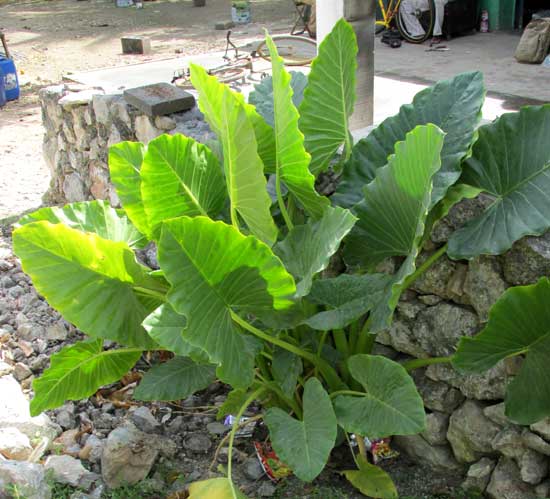
Throughout the Yucatan Peninsula, around people's houses, along stone fences -- wherever people have planted anything -- often we see impressive cluster of very large, glossy, semi-succulent, arrowhead-shaped leaves. Usually in English we call these Elephant Ears, though several species -- all with large, glossy, arrowhead-shaped leaves -- bear that name. You can see the species of Elephant Ears so commonly planted here, and which sometimes escape into the wild, at www.backyardnature.net/yucatan/elephant.htm
Once you grow accustomed to that Elephant Ears' general appearance, you begin noticing that occasionally a very similar plant turns up, except that this one tends to be a little smaller, a bit more compact, its leaf margins are a little more wavy, and -- most different -- its leaves generally point skyward, while the regular Elephant Ears' blades hang downward. Atop this page you can see the smaller, rarer species with its upward-directed leaves along a stone wall before the house of my bicycle repairman in Santa Rita.
Another less noticeable but more diagnostic anatomical feature distinguishing the Santa Rita Elephant Ears from the common one is the way the petiole connects with the blade. You can see the way it's done in the common Elephant Ears at www.backyardnature.net/n/11/111120xo.jpg
Now look at the same part of the blade of our Santa Rita plant, below:
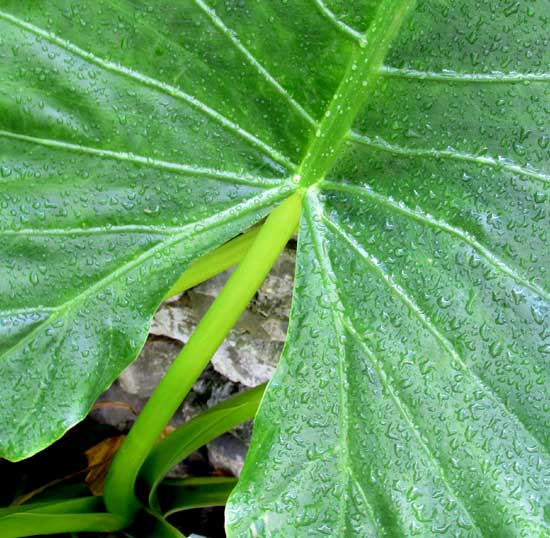
Our Santa Rita Elephant Ears' petioles are scoop-shaped at their bases, as shown below:
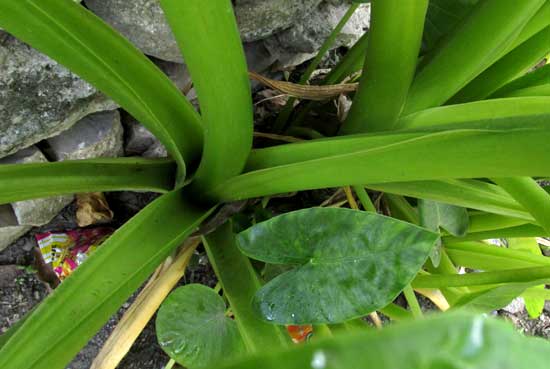
Our Santa Rita Elephant Ears is ALOCASIA MACRORRHIZOS, sometimes called Elephant-Ear Taro or Giant Taro. It's not to be confused with the Taro producing large underground tubers that provide a starchy food to people in much of the world's humid tropics. Our Santa Rita plant is "Giant Taro," not "Taro." Giant Taro is a native of India and Malaya.
We've run into this same species before, back at Chichén Itzá {next entry}, but what we had then was a much-different-looking ornamental cultivar with dark purplish petioles and veins. In fact, Alocasia macrorrhizos is such an important food crop that numerous cultivars have been developed from it.
Although Alocasia macrorrhizos, Giant Taro, isn't the famous food-producing Taro, it does produce large rhizomes up to a foot long and half a foot thick that can be eaten. However, Giant Taro's rhizomes contain such high concentrations of calcium oxalate that they burn the skin when improperly handled, and are very painful in the mouth. The roots must be cooked before eaten. Once the calcium oxalate is broken down, the roots are potato-like.
from the April 12, 2019 Newsletter issued from Rancho Regensis north of Valladolid, Yucatán, MÉXICO;
elevation ~40m (~130 ft), N~20.876°, W~88.170°
GIANT TARO FLOWERING STRUCTURE
Last March 26, as I passed through Mérida on my trip south to Guatemala, in my friend Eric's backyard I was glad to see a Giant Taro with its flowering structure intact, though the flowering period had already passed. Until now I've been unable to photograph the structure. But first, below, the whole plant is shown in a spot of shade in a sun-drenched garden
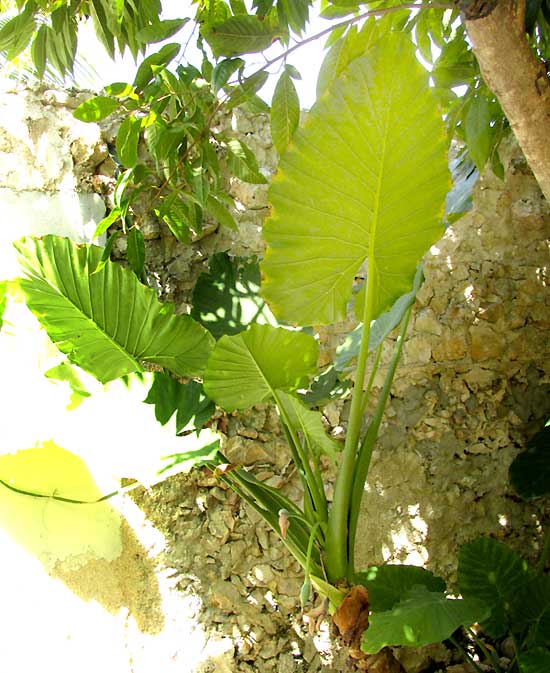
One easy-to see feature separating Giant Taro from the more commonly grown Elephant Ears is that Giant Taro's leaves habitually point upward. Also, while petioles of Giant Taro's larger leaves usually attach to the blade in the typical way, on younger leaves the petioles often attach to the blade's interior flat surface (they're "peltate"), as shown below:
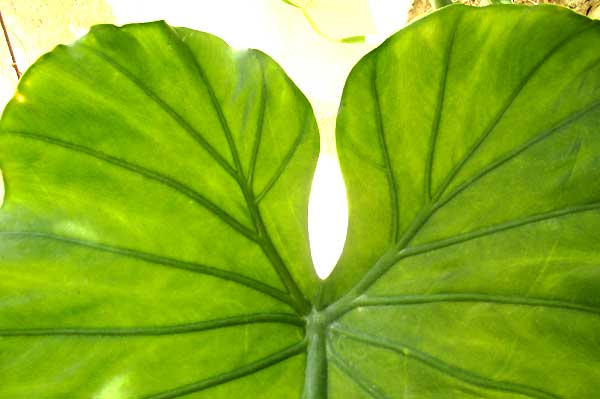
And now I can show you that the flowering structure of Giant Taro Elephant Ears is taller and more slender than that of the more common Elephant Ears, as you can see below:

Why bother with such details? Because it's simply fun to notice the differences. And Giant Taro is native to the Old World, India and thereabouts, while the more commonly seen Elephant Ears is South American.
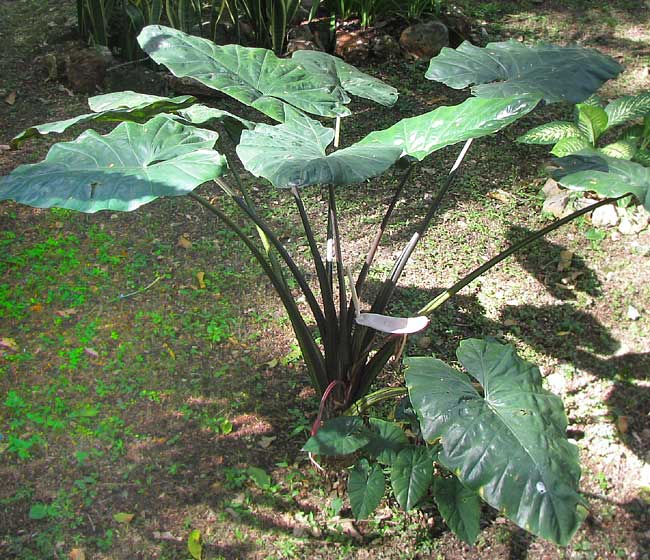
from the January 3, 2010 Newsletter issued from Hacienda Chichen Resort beside Chichén Itzá Ruins, central Yucatán, MÉXICO; limestone bedrock, elevation ~39m (~128ft), ~N20.676°, ~W88.569°
ELEPHANT EARS
As I work on Hacienda Chichen's "Plant Finding Guide" often it's a challenge to identify the plants. For example, take the case of the Elephant Ears shown above.
It's obviously what everyone up North calls Elephant Ears, but that's not saying much because members of the genera Alocasia, Colocasia, Anthurium, Caladium, Philodendron, Monstera, and Xanthosoma all are sometimes called "Elephant Ears," and often within those genera several species also share the name. Any plant with large, arrowhead-shaped leaves is likely to be called Elephant Ears. All the various Elephant Ears' leaves look pretty much the same, so usually you need the flowers for identification. Happily, the plant in the picture is flowering, as shown below:
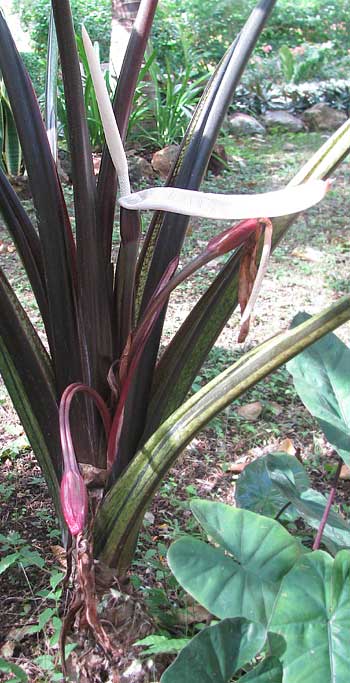
The upright, white item is a spike or spadix covered with tiny flowers and the horizontal white thing is a leafy sheath or spathe. Also note the purplish "fruits" below the spadix and sheath. With so many botanical details available you'd think that IDing the plant would be simple.
One problem is that on the Internet, which here is my main source for identification, many pictures are labeled with contradictory names. Another problem is that among the ornamentals there are many cultivars whose traits overlap one another.
Having said all that, I'm calling what's in the picture ALOCASIA MACRORRHIZA 'BLACK STEM', the "'Black Stem'" indicating that it's a special cultivar by that name. To browse a page showing several Alocasia macrorrhiza cultivars, with 'Black Stem' among them, visit http://www.agristarts.com/alocasia_main.htm.
A picture showing 'Black Stem's' black stems, with another Elephant Ear cultivar in the background that is larger and with regular green stems is below:
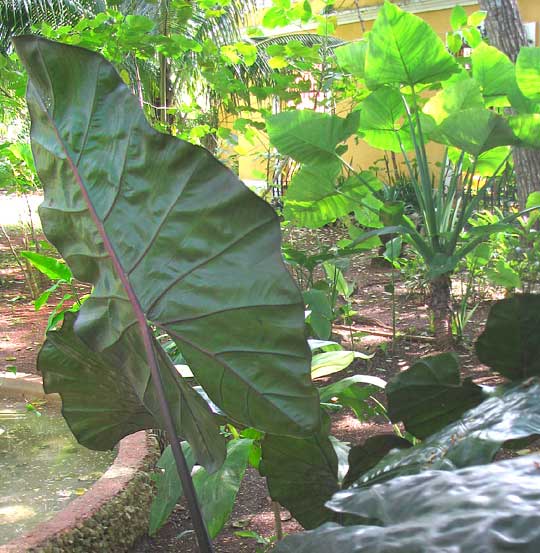
The 'Black Stem' cultivar is a smaller, more shade- tolerant form of the wild species, the "Giant Taro" of the Pacific islands and eastern Australian rainforests. The wild form, which can reach 15 feet (4.5 m) and taller has underground parts that are edible if cooked for a long time.
While I was below the plant photographing the flowers I looked up and saw something very pretty. It's below:
